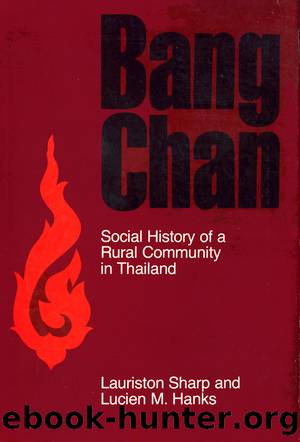Bang Chan by Lauriston Sharp Lucien M. Hanks

Author:Lauriston Sharp, Lucien M. Hanks [Lauriston Sharp, Lucien M. Hanks]
Language: eng
Format: epub
Tags: History, Asia, General, Southeast Asia, Social Science, Anthropology, Cultural & Social, Demography, Sociology, Rural
ISBN: 9781501721397
Google: 1g9QDwAAQBAJ
Publisher: Cornell University Press
Published: 2018-02-15T04:27:49+00:00
That evening a theatrical troupe played for all who came.
The Welcoming
So great was the transforming festival that the guests began to arrive in Bang Chan before preparations were complete. The canal still lay clogged with silt. Before the road had been surfaced, the Bangkok-MinburÄ« buses began lurching and plunging along its course, except when the rains reduced it to an impassable slough. When it was dry, farmers were again on their way to PratÅ« NÄm market for new treasure: flashlights, tins of milk, aspirin. Others with more to spend carried home radios, pressure lamps, and sewing machines (LS 5/17/49; SM 2/20/49). Like the head imam at the surao, some were buying the latest portable gasoline engines at 4,500 baht. In 1948 Bang Chan had only five (Sharp et al. 1953:128), but by 1955 the number had increased to seventy (Goldsen and Ralis, 1957:43). These portable gasoline engines not only could flood a seedbed and drain a fish pond within a few hours but, unlike a windmill, worked when the air was still. In 1953 a Bang Chan man rigged a long shaft with a propeller at the end and set the engine in his sampan. It took him to the temple in less than half the ordinary time. By 1960 the canals were roaring with outboard motors that were a little more convenient than the farm engines (LS 3/27/60).
Bang Chan was developing its own market, too. In 1948, besides peddlers and itinerant traders, there were only two stores. One on Kred canal sold only liquor and coffee and was open only when the landless proprietor was not hiring out to help in the fields (SM 1/18/49). At the temple was Yomâs store, where people listened to a radio and discussed the news. The proprietor, once a soldier, had married a Bang Chan girl and moved to work on his wifeâs seven rai of riceland. This patch he finally decided to rent out in order to devote himself to the store. He too provided his clientele with coffee and liquor. The store stayed open every evening until he, his wife, or his son lowered the heavy galvanized iron shutter. He also sold incense sticks, candles, paper flowers, and ceremonial cotton cord to the merit makers at the temple, and candy, pencils, and notebooks to the children at the nearby school. A kerosene tin held fuel for lamps and an old one cut down held lime to go with betel. His location presumed traffic along the canals, but gradually the highway gained importance, particularly where the bus stopped. About 1952 two stores arose on the road; they began by selling most of the same wares that Yom offered, but gradually increased their stocks with soft drinks, ice with a spoonful of pink syrup, a few vegetables from the MinburÄ« market, cakes, eggs, tins of milk, and fish. By 1953, Janlekha reports (1957:44), there was a total of nine stores in Bang Chan, including the two on the road. By 1963 the highway market had grown to eight stores.
Download
This site does not store any files on its server. We only index and link to content provided by other sites. Please contact the content providers to delete copyright contents if any and email us, we'll remove relevant links or contents immediately.
The Sympathizer by Viet Thanh Nguyen(4091)
The Rape of Nanking by Iris Chang(4019)
World without end by Ken Follett(3339)
Ants Among Elephants by Sujatha Gidla(3278)
Blood and Sand by Alex Von Tunzelmann(3055)
Japanese Design by Patricia J. Graham(2996)
City of Djinns: a year in Delhi by William Dalrymple(2430)
Foreign Devils on the Silk Road: The Search for the Lost Treasures of Central Asia by Peter Hopkirk(2385)
Inglorious Empire by Shashi Tharoor(2344)
The Queen of Nothing by Holly Black(2306)
In Order to Live: A North Korean Girl's Journey to Freedom by Yeonmi Park(2301)
India's Ancient Past by R.S. Sharma(2293)
Tokyo by Rob Goss(2286)
India's biggest cover-up by Dhar Anuj(2241)
Tokyo Geek's Guide: Manga, Anime, Gaming, Cosplay, Toys, Idols & More - The Ultimate Guide to Japan's Otaku Culture by Simone Gianni(2234)
The Great Game: On Secret Service in High Asia by Peter Hopkirk(2227)
Goodbye Madame Butterfly(2161)
Batik by Rudolf Smend(2005)
Living Silence in Burma by Christina Fink(1975)
